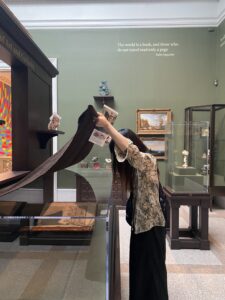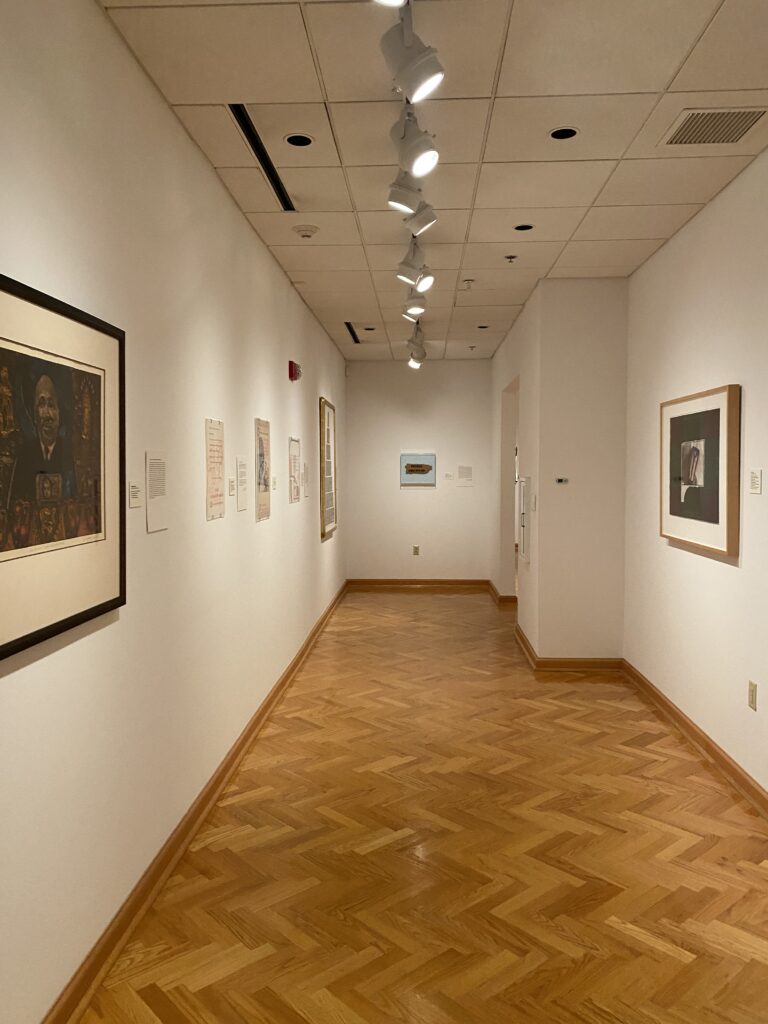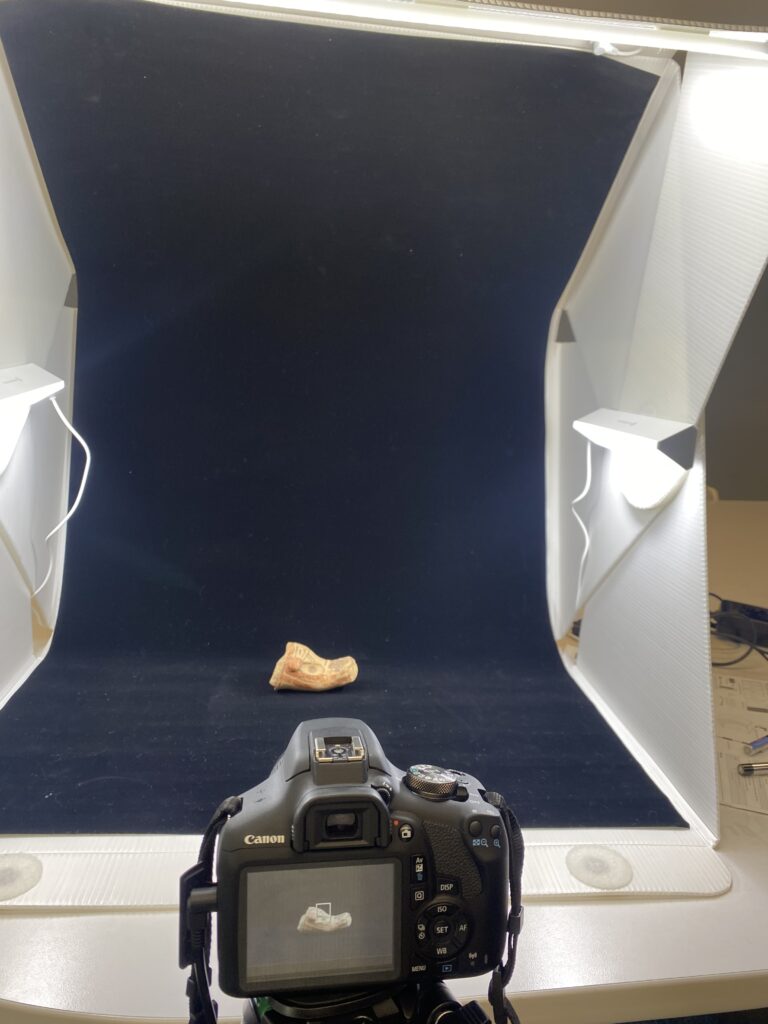Material Storytelling: Student Reflections on Object-Based Research
By Neo Khambule, Tiffany Huang, and Amanda J. Guzmán
Introduction:
Each summer, the Public Humanities Collaborative (PHC), a 10-week summer research program by the Center of Hartford Engagement Research (CHER), aims to provide Trinity College undergraduates with opportunities to contribute to faculty and Hartford community partner projects while building skillsets in archival analysis and digital scholarship. Assistant Professor in Anthropology, Amanda Guzmán recently acquired two small object assemblages, consisting of 20th century folk costume from China and archaeological pottery and stone material from Puerto Rico. These assemblages were gathered by Guzmán respectively through donation and loan for use as anthropological teaching collections. While considering that many universities have museums and object labs that foster the study of museum anthropology through hands-on study, she decided to employ these assemblages as a platform to train a pair of PHC students in object-based research through an experimental pedagogical trial period to underpin the establishment of a forthcoming Trinity College Anthropology Object Lab. The resulting summer 2024 faculty project was entitled, “Material Histories: Object Digitization and Institutional Storytelling as Practice.”
This blog describes our itinerary as two anthropology majors learning to work with objects and tell their stories.
Research Process:
While we shared a common project goal of object-based research and public writing, we were immediately prompted to consider our positionalities to/with our respective assemblages of focus. Huang’s interest in objects had been cultivated by early personal exposure to the Chinese material culture owned by her grandparents, while Khambule from South Africa held cross-cultural experiences from living in six countries and had interests in global materialities. Given her Chinese heritage, Huang was broadly acquainted with the cultural context in which her assemblage originated as she immediately recognized specific material elements in contrast to Khambule to whom the study of the Caribbean ancient past was a relatively new engagement. A crucial component of our training was the emphasis placed on intensive independent object observation or the analysis of objects in careful detail and regular taking of notes. The study of text label conventions at local museum exhibitions also helped to stage our early conceptions of what accessible object writing for multiple publics might yet look like.

We were advised to consider objects both individually and collectively as part of an assemblage. Close looking at both ourselves and our assemblages of focus as a first step laid a strong foundation by creating a critical lens for appreciating objects in their totality. This evoked a process of disentangling the potential biases and assumptions that we might bring to the work before delving into the existing body of external understandings of what has been / is defined as ‘notable’ standpoints of anthropological study. For example, Khambule noticed that she was initially drawn to stone objects with incised engravings in the Puerto Rican assemblage, but being aware of her bias ensured that research into the non-decorative objects in the assemblage were given equal attention, interest, and effort.
Continued reflection was a running theme in our work as we were asked, for example, to craft a list of online search terms for secondary research based on our object observations which we continued to refine as we built our background knowledge and skillsets in object documentation. As part of provenance research, we also conducted interviews with diverse stakeholders including current and former professors at our institution who had contributed objects to the emerging lab space as well as past student researchers. In one case, this involved a visit to a Puerto Rican contemporary art show at a nearby college gallery to better understand the positionality and art practice of one provenance stakeholder. As we began to formulate our interpretative interventions, we learned to respect the messiness and potential of multi-vocality in practice as we incorporated stakeholder perspectives and narratives as part of our growing data sets.

Project Deliverables:
As college students who produce writing mainly in class contexts, we were eager to have the outlets to present our research and findings with potentially wider audiences of relevant source communities, students and researchers. We aimed to develop informative, engaging content to reflect multiple possible standpoints of group or individual interest. The public presentation of our object-based research was to be organized across multiple formats: an ArcGIS story map for each assemblage of focus, this co-authored blog for the Council of Museum Anthropology and a beta website for the Trinity College Anthropology Object Lab. Each format invited us to take a step back to frame our narration appropriately to its context. A story map should ideally work as a stand-alone analytical research summary leaning into the platform’s features, while a blog might work better as a short reflective piece, and a website typically does the practical job of describing a space’s institutional identity.

Following preliminary research assignments of visiting local museum exhibits and participating in a Sapiens public writing workshop, our process of building original digital representations began with object photography training in varied methods from a lightbox and turntable to a stationery overhead setup. Additionally, with the support of our library’s instructional design team, we were introduced to 3D digital modelling and the software Agisoft Metashape. Such skill sets helped us to approach material close looking in new ways as well as to build interactive digital storytelling elements. Photography promoted our collective act of slow looking which enabled us to better notice seemingly small object details that we might otherwise disregard as insignificant. That said the camera, itself, is a complicated tool of cultural representation in the history of anthropology. In the words of one visual anthropologist, “Who gets to be the recorder and the recorded? What gets translated by the camera and what remains lost in mediation?” We take seriously this privilege and responsibility as digital makers. In terms of audience engagement, we are creating, for example, a website feature in which visitors can click on a pinpoint on a map to view object images, digital models, and story maps from that geographic area. In this way, the gallery archives an iterative contextual database for existing research projects illustrating both varied regional assemblage case-studies and a range of storytelling modalities. Moreover, our design of this map gallery represents a collective commitment to supporting the object lab’s continued growth through the future research of fellow anthropology majors and our college peers. The map allows for researcher reflection on equitable patterns of cultural representation and institutional capacity given the realities of semester research periods and graduating students. In this way, we understood website prototyping not only as a project deliverable but also as an ongoing productive archival problematic around promoting the object’s lab continuity and sustainability that built both on comparable institutional case-studies of material curation and our experiences with/in object digital replication.

Concluding Thoughts:
Our material exploration within the ten-week framework of our college’s Public Humanities Collaborative revealed both the limitations and potential of object-based student learning templates. We transparently acknowledge the constraints posed by both our emerging skill sets and restricted summer project timeline, which eliminated the possibility, for example, of conducting a more scientific provenance analysis. Yet, our growing understanding of the various ways by which we might approach the observation and interpretation of objects practically demonstrated the value (and perhaps, more importantly, the challenge) of integrating diverse perspectives and experiences. Over the course of our research process, key, ongoing questions were raised about best practices around data access and stakeholder authority in community engaged student object-based research. How could we balance our ethical responsibility to stakeholders who loaned and gifted object collections for undergraduate learning through informed consent forms and regular project communication with calls to publicly share our research results and digital deliverables as student researchers through campus events with wider relevant stakeholder communities? How could we help to build and maintain multiple, long-term partnerships based on trust and mutual benefit with the transition of student researchers over the course of different research periods? These questions, which animated our internal group discussions, will begin to be addressed in a forthcoming mission statement and collection policy for the Trinity College Anthropology Object Lab.
The opportunity to conduct collections-based work as part of the exploratory pilot work of this departmental lab space for future anthropology majors has been an, at times, daunting but ultimately meaningful opportunity to not only analyze object assemblages in-depth but also to appreciate the complexities of being a material storyteller – weaving together object traces, associated oral and archival records alongside existing bodies of academic interpretation. Storytelling in our experience is complicated by the affordances of digital tools. Our improved proficiency with platforms like ArcGIS and Metashape will expand the accessibility of our object research, offering more tangible engagement than traditional forms of scholarship, but also necessitates important considerations around digital preservation management and ownership.
Our assemblage research and contributions to the new departmental lab space will continue to take shape throughout our college careers as we, for example, seek out reviewers and translators for our story map work. This summer’s digital work will in turn materialize as we also provide hands-on support for collection rehousing efforts into archival storage as the object lab is installed in a physical campus location. We hope that professors and students alike might benefit from our mediations here on how object-based work expanded and transformed our frames of reference for how we defined anthropological fieldwork and field sites through the lens of objects.
Blog Authors:
Amanda J. Guzmán is an Assistant Professor in Anthropology and the co-director of the Center for Caribbean Studies at Trinity College in Hartford, Connecticut. She is a member of the inaugural 2024-2025 Rooted + Relational research cohort at the Center for Puerto Rican Studies at Hunter College engaging with the theme of “Archives, Memory, and the Present Past.”
An international student from Guangzhou, China, Tiffany Huang studies Anthropology and Economics at Trinity College in Hartford, Connecticut. In spring 2025, she will continue to build her object-based and digital storytelling skillsets as a research assistant with the Trinity College Anthropology Object Lab. Driven by a passion for museums and cultural anthropology, Tiffany intends to pursue a graduate degree.
Neo Khambule is a South African and Dutch student at Trinity College in Hartford, Connecticut. She is currently studying Anthropology, Arabic, and Urban Studies. Neo has carried forward her research interests in object-based learning by studying Archaeology as a visiting student at the University of Oxford during the 2024 – 2025 academic year.
